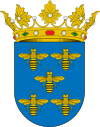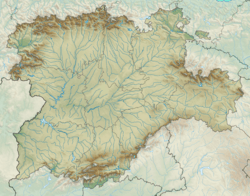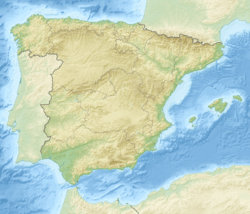Béjar facts for kids
Quick facts for kids
Béjar
|
||
|---|---|---|
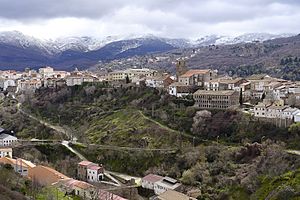 |
||
|
||
| Country | Spain | |
| Autonomous community | Castile and León | |
| Province | Salamanca | |
| Area | ||
| • Total | 46 km2 (18 sq mi) | |
| Elevation | 959 m (3,146 ft) | |
| Population | ||
| • Total | 12,961 | |
| • Density | 281.8/km2 (730/sq mi) | |
| Demonym(s) | bejarano | |
| Time zone | UTC+1 (CET) | |
| • Summer (DST) | UTC+2 (CEST) | |
| Postal code |
37700
|
|
| Dialing code | 923 | |
Béjar (Spanish pronunciation: [ˈbexaɾ]) is a town in Spain. It is located in the province of Salamanca, which is part of the Castile and León region. In 2018, about 12,961 people lived there. Béjar has a long history tied to making fabrics and clothes.
Contents
History of Béjar
How Béjar Started
Béjar was founded around October or November in 1208. It was first located south of where it is now. But in the early 1300s, people moved the town to its current spot. The town grew quickly because its economy was based on raising animals.
For many years in the Middle Ages, Béjar was sometimes ruled by the king and sometimes by a local lord. The town had a special set of rules called a fuero, which was confirmed in 1333. Every year, Béjar held a medieval fair that lasted for eight days! The town had lots of wood, water power, and sheep.
Textile Industry Grows
Around 1396, the Zúñiga family became powerful in Béjar. This meant more people, like their helpers and staff, moved to the town. This increased the demand for clothing. So, making fabric became very popular in the late 1600s. The Duke of Béjar even brought skilled workers from Flanders to teach new ways of making wool.
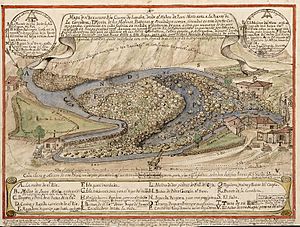
Unlike other places in Spain, Béjar's textile industry kept going strong even after the Early Modern Period. In the 1800s, Béjar was so famous for its fabric factories that people called it the "Castilian Manchester." This was a nod to Manchester, England, which was a huge textile center.
Modern Times and Changes
Because Béjar is in a remote area with rough land, the railway arrived late, in 1894. After the Spanish Civil War, Béjar became a major supplier of wool clothes. These were mainly used for military and government uniforms.
Béjar's population grew until 1970, reaching its highest point with 17,576 people. But in the 1970s, the textile industry faced problems. Factories had to cut jobs. Passenger train services stopped in 1985, and freight trains stopped ten years later. This made it harder for businesses and caused many people to move away. Now, Béjar is trying to grow its economy through tourism.
What Does Béjar Mean?
The name Béjar probably comes from a language spoken before the Romans arrived. It has been written as Biclara and Biclaro in old documents.
Famous Places to Visit
Béjar has many interesting historical buildings and monuments:
- City Walls: These are old medieval walls that are still in good condition.
- Church of Saint James (Santiago): Built in the 1100s, this church is now a Museum of Religious Art.
- Church of Saint Mary the Great (Santa María la Mayor): This church was built between the 1100s and 1600s. It shows many different building styles, from Mudejar to Baroque.
- Jewish Museum David Melul: This museum teaches about Béjar's Jewish history.
- Ducal Palace and Camera Obscura: This was once an old fort. In the 1500s, it was turned into a palace for the Duke and Duchess of Béjar.
See also
 In Spanish: Béjar para niños
In Spanish: Béjar para niños


